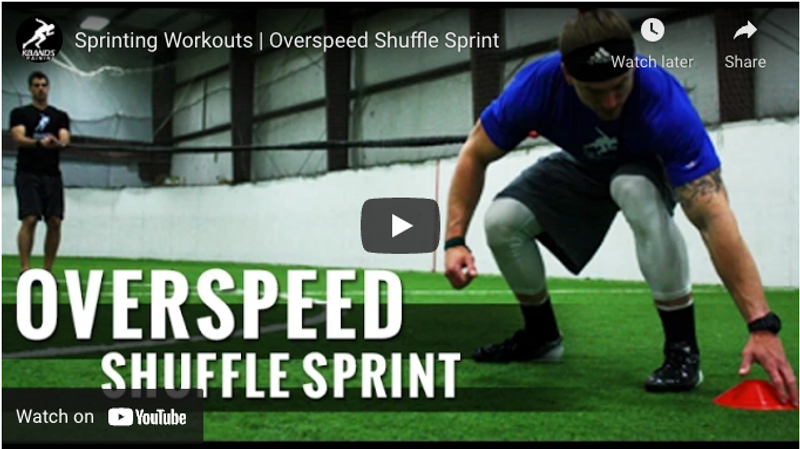Kbands Overspeed Shuffle Sprint
Exercises involving assisted sprinting or sprinting workouts that rely on the burden of added resistance—have been proven to help sprinters and runners improve their stride frequency. When runners are held back by resistance that targets the center of gravity or core area, the entire body works to dig in deeper and drive the knees harder to cover the same amount of ground in the same time frame. This results in faster muscle development, better stability, and a higher level of agility and control, all of which contribute to an elevated stride frequency and a faster sprint.
The drill demonstrated in this video is called the Overspeed Shuffle Sprint Drill, which uses the principles of added resistance to help athletes focus on core strength and stride frequency during short bursts of explosive speed. This drill will take advantage of the benefits of the Reactive Stretch Cord, a powerful Stretch Cord that clips to a band around the user’s torso. With the Reactive Stretch Cord in place and the handle under the control of a coach or partner, athletes will need to dig in and add power to cover the same ground during an explosive sprint.
This drill is simple in execution and requires very little time and equipment. It can be easily worked into any regular training program for athletes in any sport, and it can bring results to runners of any age at both beginning and advanced levels. This exercise is especially useful for athletes who rely on quick bursts of well controlled speed on the field, like football, lacrosse, and soccer players.
Sprinting Workouts: Setting Up the Drill
The Overspeed Shuffle Sprint Drill will require three speed and agility cones (available for purchase at KbandsTraining.com) and a Reactive Stretch Cord for each participant. The cones can be placed in a straight line about three to five yards apart, and the Reactive Stretch Cord belt can be strapped in place around the athlete’s torso and clipped to the cord. Athletes should make sure the belt is snug so the D-ring stays in place.
Since the Reactive Stretch Cord can be safely stretched to a distance of about 20 feet, the line of cones should stay within this limit. This drill will also require the assistance of a partner or anchor, who will stand at one end of the line of cones and hold the cord tightly around the wrist.
Overspeed Shuffle Sprint: Executing the Drill
As the sprinting workout begins, the athlete will stand at the first cone with a lowered center of gravity, waiting for the starting signal. At the signal, the athlete will begin a full speed lateral shuffle toward the second cone. The runner should keep a few things in mind during the lateral sprint phase: First, the sprint should stay explosive all the way to the cone, and should not slow down at the approach. Second, the tension in the band should not control the athlete’s velocity. Full speed should be maintained at all times.
Upon reaching the first cone, the runner should stop, turn back toward the starting point, and sprint back to the first cone in a straightforward orientation. Then the runner should face in a lateral direction again and sprint out to the second cone.
The same technique and principles will apply to the longer sprint; the athlete should keep the center of gravity low and control speed and stride frequency during the entire distance. Upon reaching the final cone, the athlete should stop, turn, and sprint back to the starting point.
During the final stretch, the athlete should not stop at the first cone, but should keep running full speed down the field. This will require the anchored partner to drop the handle of the Reactive Stretch Cord quickly so the resistance doesn’t interfere with this final sprint length.
The anchor should stay flexible, observant and responsive throughout the drill. The degree of resistance applied to the sprint should be just enough to require extra effort, but not enough to interfere with technique or running stride. As the runner approached the third cone, the anchor can feel the tension in the band and note the runner’s posture, and if the tension is too high, the anchor can move toward the runner by a few steps to optimize the length of the cord.
The anchor should pay special attention to any signs of over-striding or breaking. If the body is facing too much resistance, the runner will natural break or fall back on the heels, which won’t help with stride performance. At all times, the runner’s upper body should be positioned just above the center of gravity, not leaning behind or falling back.
Drills to Improve Speed: Final Notes
Athletes should complete three to four resisted reps of this sprinting workout on both sides of the body, which means the cones can stay in place, but after four reps with the anchor standing on one side, the anchor can move to the other end of the line of cones and the drill can be repeated from the other side.
Sprint drills that make use of an added level of resistance, also called assisted sprints, offer a proven method of building speed and increasing stride frequency over short distances. By working drills like this one into a regular training program, teams can quickly build speed, responsiveness, and stability during explosive runs and fast direction changes.

